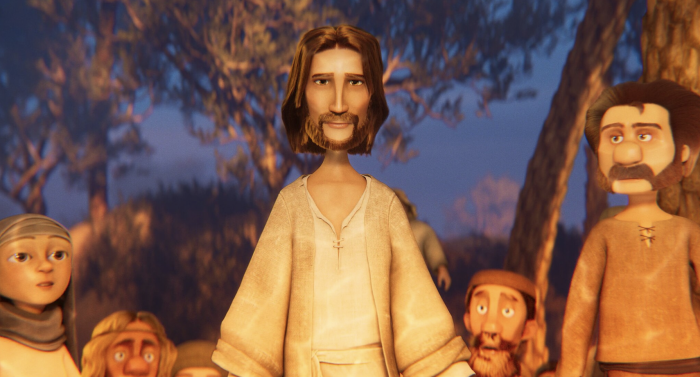
When Angel Studios’ “The King of Kings” opens in theaters on April 11, audiences will see something rarely attempted in animation: the life of Jesus Christ, retold through the eyes of a child and inspired by the prose of Charles Dickens.
For South Korean director Jang Seong-Ho and cinematographer-producer Woo-hyung Kim, the project is an attempt to deliver a message of Jesus’ love to a global, increasingly secular audience.
“I was a big fan of films and animation,” Jang told The Christian Post through a translator. “And at the same time, I read all of Charles Dickens’ books. Later on, I found out that there’s this book, The Life of Our Lord, and I read it. After reading it, I thought it would be very unique to talk about Jesus’ story through Charles Dickens.”
That inspiration led Jang, a first-time feature director, to take on the challenge of adapting the Gospel narrative for animation — using Dickens’ literary voice to guide the story.
“There’s a lot of content talking about Jesus’ story, but delivering those messages through the perspective of Charles Dickens — I thought that will be meaningful, and also it will bring uniqueness,” he said.
The animated film, set against the backdrop of Victorian England, follows Dickens as he tells the story of Jesus to his child. It features a star-studded voice cast that includes Kenneth Branagh, Uma Thurman, Pierce Brosnan, Mark Hamill, Roman Griffin Davis, Forest Whitaker, Ben Kingsley and Oscar Isaac. Kristin Chenoweth both co-wrote and sings the film’s closing song, “Live Like That.”
Jang, a professing Christian, said his personal faith journey played a significant role in his decision to direct the film.
“As a Christian myself, I was a little bit surprised that there aren’t any feature film animations that talk about Jesus’ story,” he said. “So there was big motivation for me.”
Jang said the film was also born out of concern for his own country; South Korea has one of the largest Christian populations in Asia, but attendance among young people is in decline, according to the Pew Research Center.
“There are a lot of Christians in Korea,” he said. “But at the same time, sadly, there are a lot of people who are opposed to the Korean Christian population. And nowadays, not many young people […] are going to church.”
He saw “The King of Kings” as a way to offer a message of hope and truth. “I thought, there’s a need for someone to deliver the message of Jesus in the right way […] to all the people there,” he said.
Jang said that while faith served as a foundation for the project, it also had to be balanced with the practical demands of the production. “There are a lot of aspects to producing animation, and I know that it cannot only be fulfilled […] with faith,” he said. “There’s a lot of aspects that I have to consider, including the technical aspects and the business aspects.”
To bring the world of “The King of Kings” to life, the production relied heavily on advanced motion capture and virtual cinematography. Kim, who handled both producing and cinematography, described a layered and time-consuming process.
“We hired the actors first, and then we captured the motions,” he said. “And then once it completes, I go into the virtual world with my virtual camera, and I do the camera movements there, again and again.”
Voice acting and facial expressions were recorded separately and added to the animation. “It’s not like live-action films. It just happens gradually, step by step,” he said. “Basically, it’s not a simple process.”
The goal, Kim said, was to make the film feel like more than just animation. “He wanted the audience [to] feel this film, obviously as an animation, but also as a conventional cinema,” Jang added.
While working on a film about Jesus brings its own pressure, both Jang and Kim pointed to specific scenes that presented creative and technical challenges.
For Kim, a scene depicting a storm stood out. “Technically [it was] hard… because we did it for the first time,” he said. “We made it like five, six years ago… seven years ago.”
At that time, the team didn’t have access to the virtual production tools they would later use. “Everything had to be done digitally — all the camera movement, acting and voice,” he said. They later rebuilt the scene with improved tools but had to stay true to the earlier version. “That was technically quite challenging,” he said.
Jang pointed to a quieter moment — a scene in which Charles Dickens walks up the stairs at home to tell his child a story.
“People may be surprised to hear about this,” he said. “The scene […] needed to establish the relationship between Charles Dickens and his wife. […] And at the same time, […] Dickens must have been persuaded to tell the story to his child. It was very important to express that emotional […] establishment within the short scene.”
The challenge, he said, was explaining the nuance to animators. “It was quite challenging for me as a director.”
For Kim, the hope is simple. “I always want this film to be shown by as many audiences as possible,” he said.
Jang added that he hopes viewers leave with an understanding of the Gospel message. “This entire project began with my thinking that I wanted to extract just one word from the entire Bible,” he said. “I thought that was love. Jesus is love.”
“I want them to feel that the reason for His sacrifice is His love for us,” he added. “That is the message that I want the audience to bring back home after they watch this.”